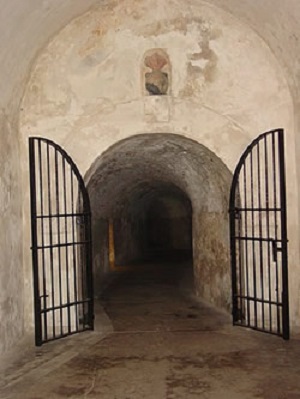
Courtesy of National Park Service
Casa Blanca and La Fortaleza were the first fortifications the Spanish constructed in San Juan after Columbus reached Puerto Rico in 1493. Erected in 1525, the Casa Blanca was a small blockhouse the Spanish settlers built during the first years after San Juan’s establishment in 1521. The house provided defense against attacks from the Caribbean Indians and a home for the Puerto Rican governor’s family, who at the time were the descendants of the Spanish explorer Juan Ponce de Leon. The second stronghold, La Fortaleza, also known as "Palacio de Santa Catalina" (Santa Catalina Palace), was completed by the Spanish in the 1530s. La Fortaleza was and continues to be the residence of governors. Although greater in size and strength, La Fortaleza provided only minimal protection for the port of San Juan Bay.
Recognizing their mistake with the positioning of La Fortaleza, the Spanish began construction of a stronger and more efficient fortification for the protection of the city’s anchorage at the entrance of the San Juan harbor in 1539. Castillo de San Felipe del Morro has a round masonry tower and resembles a castle. By 1596, El Morro’s strategic location and four-canon defense system proved successful after it withstood the first British attack, which was led by English privateer Sir Francis Drake. Although the Spanish defeated Drake’s forces, the English Crown was determined to seize Puerto Rico and, in 1598, commissioned the Earl of Cumberland to lead the second attack on San Juan.
Cumberland realized Drake’s mistake in attacking the Spanish fortification from the harbor entrance and instead besieged El Morro from behind through a successful land attack. Eventually, the Spanish regained control of the fort after an epidemic forced the English to abandon El Morro, which the Spanish rebuilt to protect the fort from future land approaches. In 1625, the fortification withstood the Dutch invasion but was unable to protect the city, which the Dutch burned down on their way out of San Juan. Following the attack, the Spanish spent the next 150 years building a defense line around San Juan to defend the city and its people from enemy attacks. Completed in 1678, the 50-foot high wall stretched from El Morro to San Cristobal, thus bordering the city on both sides.
Castillo de San Cristobal, which dates from 1634, was part of the new defense line to protect San Juan against land approaches coming from the east. The Spanish erected the fortification on the northeastern edge of San Juan, which was 150 feet above sea level and a mile away from the headland where El Morro stood.
The smaller Fort San Juan de la Cruz (1606), which lies across from Fort San Felipe del Morro, had the strategic purpose of providing crossfire to El Morro and additional protection of the entrance to the harbor.
In 1678, King Charles III--who had designated San Juan as the defender of the first order--sent two Irishmen to strengthen the city’s fortifications and defense lines. By the end of the 1780s, Thomas O’Daily and Alexander O’Reilly had rebuilt El Morro, San Cristobal, and the defense wall into its present day image, thus transforming San Juan into the most powerful stronghold in America.
With the new upgrades, San Cristobal became the largest Spanish fortress in the New World with 450 canons and expanding over 27 acres of land. The Irish engineers designed the defense system on the principle of “defense in depth,” which meant that enemies would have to break several barriers--that were each higher and stronger than the one before them—to besiege the fort. In 1797, the in depth defense design of San Cristobal proved successful when Sir Ralph Abercromby’s British forces were unable to seize the city after a failed attempt to break the first barrier. Although the British attacked the fortification, San Cristobal never fired a shot, thus proving the strength and effective engineering that went into building the fort’s barriers. For 100 years, San Cristobal would not fire a single shot; it was not until the Spanish American War in 1898 that one of the fortification’s guns fired the first shot into the Atlantic.
At the conclusion of the Spanish American War in 1898, the United States gained control of Puerto Rico. The forts of Old San Juan continued to serve their military purpose by defending the American territory until the end of World War II. Today, at San Juan National Historic Site, the National Park Service protects the forts so visitors can explore them and learn their stories.
San Juan National Historic Site, a unit of the National Park System, is located at Norzagaray St. in Old San Juan, PR. Click for the National Register of Historic Places file: text and photos. La Fortaleza/San Juan National Historic Site has been designated a World Heritage Site, as well as a National Historic Landmark. La Fortaleza is open 8:00am to 3:00pm on weekdays. For more information, call 787-721-7000. Castillo de San Cristobal and Castillo San Felipe de Morro are open daily from 9:00am to 6:00pm, except on Thanksgiving, Christmas Day, and New Year’s Day. For more information, visit the National Park Service San Juan National Historic Site website or call 787-729-6777.
Many components of the San Juan National Historic Site have been documented by the National Park Service’s Historic American Buildings Survey, including the Castillo de San Felipe de Morro’s Lighthouse, the Castillo de San Cristobal’s Entrance Gate, Northeast Gate, South Gate, Guardhouse, and the Troops Quarters.
San Juan National Historic Site is featured in the National Park Service Historic Places in Puerto Rico and the Virgin Islands Travel Itinerary. San Juan National Historic Site is also the subject of an online lesson plan, The Forts of Old San Juan: Guardians of the Caribbean that is available in both English and Spanish. Click here for the Spanish version of the lesson plan produced by the National Park Service’s Teaching with Historic Places program.
Last updated: August 8, 2017
